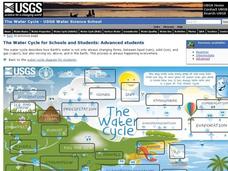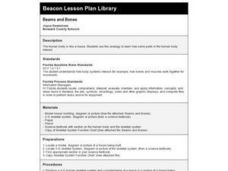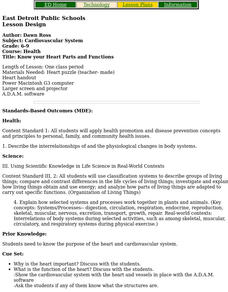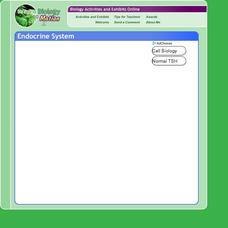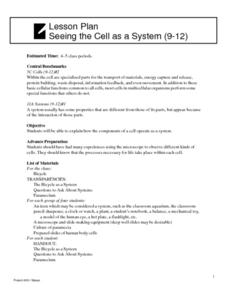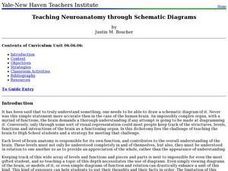Curated OER
T's Alive! Or Is It?
Learners explore data on the bone, muscle, and skin of living systems and then create a list of characteristics of these systems and relate these characteristics to bone, muscle, and skin.
Curated OER
The Ear
In this ear anatomy worksheet, students complete an on-line interactive exercise. Students analyze a detailed diagram of the ear. Students drag the names of ten parts of the ear to the correct spot on the diagram.
University of Minnesota
Virtual Neurons
It's electric! Young anatomists use Virtual Neurons software to build, control, and analyze complex nerve circuits within the body. Colorful and packed with content, class members enjoy interacting with the nervous system at a personal...
Ask a Biologist
Human Skeleton Anatomy Activity
Young biologists piece together the puzzle of the human body with this simple anatomy learning exercise. Presented with a picture of the human skeleton, students are challenged with the task of correctly identifying the 27 bones...
US Geological Survey
The Water Cycle for Schools: Advanced Ages
Explore the water cycle in an interactive diagram of the process. The diagram shows how water is a moving system and constantly changing forms. The resourc includes vocabulary words that pupils click on in order to discover more about...
Curated OER
Remembering the Respiratory System
Sixth graders analyze the components of the respiratory system. In this respiratory system lesson, 6th graders participate in hands on experiments and activities to identify the functions of the major organs of the respiratory system.
Curated OER
Digestive System
Students explore the parts of the digestive system. Using interactive spreadsheet software, students observe, name and describe the function of each part of the digestive system. Students may work individually or in pairs.
Laboratory for Atmospheric and Space Physics
The Solar Wind Tunnel
The winds of change are blowing in our very own solar system! But what makes some heavenly bodies more affected by solar winds than others? Pupils discover the concept of magnetic forces at work in space in this attractive interactive,...
American Museum of Natural History
Gusty: The Gut Microbiome Card Game
Build up your gut. Groups up to four play a card game to learn more about the microbiome in the gut. Learners try to build a healthy gut with their cards. The player acquiring six microbes without any pathogens wins the game.
Concord Consortium
3D Exploration of Bound Antibody and Antigen
Our body manufactures antibodies that are the exact shape for the antigens it encounters. The simulation shows a 3-D model of an antibody and antigen pairing. It allows young scientists to explore the complementary shapes.
Curated OER
The Skeletal System
Students identify the different parts of the skeletal system. In this biology lesson, students put together a skeleton using an interactive website. They evaluate the accuracy of their own answers.
Curated OER
Beams and Bones
Fifth graders learn how parts of the human body interact and how bones and muscles work together.
Curated OER
Hierarchy Theory and Biotic Hierarchy
Learners examine the hierarchy theory and biotic organization by playing a teacher-created card game matching groups of items, such as organelles, in suits of four. They discuss the reasons for their hierarchical organization of the...
Curated OER
The Circulatory System
In this circulatory system worksheet, students label a diagram of the heart and answer 12 questions about the heart and the circulatory system.
Curated OER
Know your Heart Parts and Functions
Students put together a 3-D interactive "heart" puzzle and learn the names of heart parts.
Biology in Motion
Thyroid Gland and Negative Feedback
Many glands work together to control hormone levels in the body. The interactive focuses on the thyroid gland, pituitary gland, and the hypothalamus. It demonstrates the interconnections and feedback loops present in the endocrine system.
Curated OER
The Nervous System
In this online interactive nervous system worksheet, students respond to 11 multiple choice and fill in the blank questions regarding the information included in the provided paragraphs.
Curated OER
Building a Circulation City
Students examine how the workings of the human circulatory system were discovered. In this circulation lesson students view a video, divide into groups and act out their given system.
Curated OER
Exercise and Muscles
Eighth graders identify and label the primary and secondary muscles used to perform an exercise. Students perform an exercise on a weight machine to figure out which muscles are being used. Students illustrate the muscles used by...
Curated OER
Biology E3 Project Instructional Plan
Ninth graders design a device to treat aneurism. In this biology lesson plan, 9th graders create a polymer in the lab and explain its uses. They identify the different diseases affecting the circulatory system.
Curated OER
Seeing the Cell as a System
Students explain how the components of a cell operate as a system. Students examine a bicycle and find out if parts were arranged differently, could the system still be carried out. They look at cells as well and see what function they...
Curated OER
Teaching Neuroanatomy through Schematic Diagrams
Students identify the parts and function of a neuron. They explain and illustrate the levels and functions of the nervous system including neurons and the Central and Peripheral Nervous Systems. They analyze and diagram the Lobes and...
Curated OER
Take Deep Breath
Fifth graders become familiar with how the diaphragm expands to draw air into our lungs and contracts to exhale carbon dioxide. They also label the major parts of the respiratory system through the use of interactive Internet research...
Curated OER
TE Lesson: Fighting Back!
Learners examine the roles of the immune system in keeping the body healthy. They see how engineers contribute to this process by creating antibiotics, and vaccinations. They discuss how an astronauts' immune system may be suppressed...






